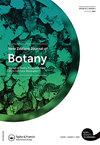质体基因组序列与早期东波利尼西亚航海家在诺福克岛和查塔姆群岛引入的石鸡一致,但没有替代解释
IF 1.4
4区 生物学
Q4 PLANT SCIENCES
引用次数: 2
摘要
摘要:长期以来,Phormium tenax(harakeke,新西兰亚麻:沥青科)一直被认为是新西兰(包括查塔姆群岛)和诺福克岛的本土植物。然而,诺福克岛上的P.tenax的土著性尤其受到另一种假设的挑战,即它是在欧洲殖民之前由东波利尼西亚人引入的。我们使用一个过时的系统发育树来检验这个替代假设。我们还测试了Phormium的年代系统发育树是否可以与其分布的替代解释相一致。我们检测了P.tenax、P.cookianuman和相关植物的接近完整的质体基因组序列。然后,我们使用化石校准,并分别使用生物地理学校准,假设跨洋分布的替代解释,对诺福克岛和新西兰材料之间的差异年龄进行了贝叶斯和似然估计。诺福克岛植物的DNA序列是不变的,并且在更广泛的P.tenax多样性中嵌套良好。使用化石校准对分歧时间的估计并没有排除第二个千年前的共同祖先。查塔姆群岛的P.tenax的DNA序列也嵌套在来自新西兰的P.tenex的多样性中,但由于它们与新西兰植物的差异,年龄估计更老(约20000–400000年)。生物地理校准导致了树内更深节点的极其古老的年龄(数百亿年),或者谱系之间的比率有几个数量级的变化。我们的结果与东波利尼西亚人迁移哈拉克人的结果一致,但我们的分析不能排除晚第四纪的自然扩散事件,这可能会导致类似的遗传模式。基于冈瓦纳大陆解体的生物地理校准意味着与当代地球历史观念的重大偏离,或谱系之间的数量级速率变化。本文章由计算机程序翻译,如有差异,请以英文原文为准。
Plastid genome sequences are consistent with introduction of Phormium tenax to Norfolk Island and Chatham Islands by early East Polynesian voyagers but not vicariance explanations
ABSTRACT Phormium tenax (harakeke, New Zealand flax: Asphodelaceae) has long been considered indigenous to New Zealand (including the Chatham Islands) and Norfolk Island. However, the indigeneity of P. tenax on Norfolk Island, in particular, has been challenged by an alternative hypothesis that it was introduced by East Polynesians prior to European colonisation. We tested this alternative hypothesis using a dated phylogenetic tree. We also tested whether dated phylogenetic trees of Phormium could be reconciled with vicariance explanations of its distribution. We examined near-complete plastid genome sequences of P. tenax, P. cookianumand related plants. We then undertook Bayesian and likelihood estimation of the age of the divergence between Norfolk Island and New Zealand accessions using fossil calibration, and separately using biogeographic calibration assuming vicariance explanations of trans-oceanic distributions. DNA sequences of Norfolk Island plants were invariant and nested well within the wider diversity of P. tenax. Estimates of divergence times using fossil calibration did not exclude a common ancestor as recent as the second millennium CE. DNA sequences of Chatham Islands P. tenax were also nested within the diversity of P. tenax from New Zealand, but age estimates were older for their divergence from New Zealand plants (around 20,000–400,000 years). Biogeographic calibrations resulted in extremely ancient ages (tens of billions of years) of deeper nodes within the tree or several orders of magnitude variation in rates among lineages. Our results are consistent with translocation of harakeke by East Polynesian people, but our analyses cannot exclude a Late Quaternary natural dispersal event, which might result in similar genetic patterns. Biogeographic calibrations based on the break-up of Gondwana imply major departures from contemporary ideas of Earth's history, or orders of magnitude rate variation among lineages.
求助全文
通过发布文献求助,成功后即可免费获取论文全文。
去求助
来源期刊

New Zealand Journal of Botany
生物-植物科学
CiteScore
2.20
自引率
22.20%
发文量
27
审稿时长
>12 weeks
期刊介绍:
The New Zealand Journal of Botany publishes original research papers, review papers, perspectives, short communications, forum articles, letter and book reviews. We welcome submissions relevant to all aspects of the botany, mycology, and phycology of the South Pacific, Australia, South America, and Southern Africa. The journal’s subject matter encompasses biosystematics and biogeography, ecology, physiology, biochemistry, genetics, reproductive biology, structure and development, taxonomy, ethnobotany, palaeobotany, bryology, lichenology, mycology, plant pathology, and phycology.
 求助内容:
求助内容: 应助结果提醒方式:
应助结果提醒方式:


